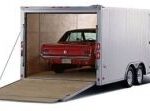When you think about gallons in a car, you might immediately consider fuel tank capacity. But have you ever wondered about water tanks in specialized vehicles? It turns out, some cars are ingeniously designed to carry a surprising amount of water, transforming them into mobile homes capable of supporting groups of people.
Imagine a car engineered to accommodate not just passengers, but also their daily needs like showering and sanitation. One such vehicle impressively manages to cater to a large group. Typically carrying 6 overnight passengers, and up to 10 during the day, this car can even handle 14 people in a squeeze. What’s remarkable is its water system, designed to provide showers for everyone on board.
This unique car boasts a water tank capacity sufficient for around 15 minutes of showering per person on a single fill. To achieve this, it employs an air-operated water raising system, running at 25psi, powered by either a 24v compressor or the trainline, depending on the operational context. The water is efficiently elevated into a standard domestic hot water heater, positioned strategically above the floor at the vehicle’s end.
Water conservation is clearly a priority. The vehicle is equipped with water-saving shower heads. On a “scrooge setting,” a quick 5-minute shower consumes approximately just one gallon of water. The system is adaptable, allowing for adjustments to increase water flow when fewer people are using it or when refill opportunities are plentiful. The use of a 24-volt compressor enables operation from batteries when stationary, avoiding the need for a noisy generator. Adding to the home-like amenities, the car features a regular domestic toilet situated above the floor with a tank underneath.
A distinctive feature that passengers appreciate is the inclusion of an opening window in the shower cubicle. This thoughtful design allows for a refreshing shower experience, even offering the chance for a playful interaction with the outside world – imagine briefly surprising onlookers while shampooing!
Interestingly, the water in the tanks isn’t intended for drinking. The tanks are constructed from normal mild steel. The decision was made that instead of investing in upgrading to stainless steel tanks for potable water, it was more practical and cost-effective to purchase spring water for kitchen use. This choice was also influenced by the uncertainty surrounding the water source when using track or station taps for refills.
This glimpse into a car with an unexpectedly large water capacity highlights the innovative ways vehicles can be adapted for specialized needs, focusing on efficiency and passenger comfort.

